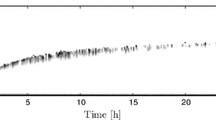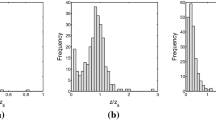Abstract
A set of smoothed temperature gradient profiles around overshooting layers at the solar convective zone bottom is considered. In classical local theories of convection the one point defined according to the Schwarzschild criterion is enough to describe a convective boundary. To get a sophisticated picture of the overshooting we use four points to compute the transition overshooting functions. Analyzing the transition gradient profiles we found that the overshooting convective flux may be either positive or negative. A negative overshooting flux appears in nonlocal convective theories and causes a steep temperature gradient profile. But we propose an evenly smoothed gradient which corresponds to a convective flux positive everywhere. To outline the effect of the temperature gradient on the solar oscillations the squared Brunt–Väisälä frequency N 2 is calculated. In local convective theories the N 2 profile shows the discontinuity of the first derivative at the convective boundary, while all smoothed profiles eliminate the break.
Similar content being viewed by others
References
Brunt, D.: Quart. J. R. Meteorol. Soc. 53, 30 (1927)
Cox, J.P., Giuli, R.T.: Principles of Stellar Structure. Gordon and Breach, New York (1968)
Deng, L., Xiong, D.R.: Mon. Not. R. Astron. Soc. 386, 1979 (2008)
Monteiro, M.J.P.F.G., Christensen-Dalsgaard, J., Thompson, M.J.: Mon. Not. R. Astron. Soc. 316, 165 (2000)
Shaviv, G., Salpeter, E.E.: Astrophys. J. 184, 191 (1973)
Skaley, D., Stix, M.: Astron. Astrophys. 241, 227 (1991)
Väisälä, V.: Soc. Sci. Fenn. Comment. Phys.—Math. II 19, 37 (1925)
Xiong, D.R.: Astron. Astrophys. 213, 176 (1989)
Author information
Authors and Affiliations
Corresponding author
Rights and permissions
About this article
Cite this article
Baturin, V.A., Mironova, I.V. Smooth models of overshooting at the base of the solar convective zone. Astrophys Space Sci 328, 265–268 (2010). https://doi.org/10.1007/s10509-009-0263-8
Received:
Accepted:
Published:
Issue Date:
DOI: https://doi.org/10.1007/s10509-009-0263-8




